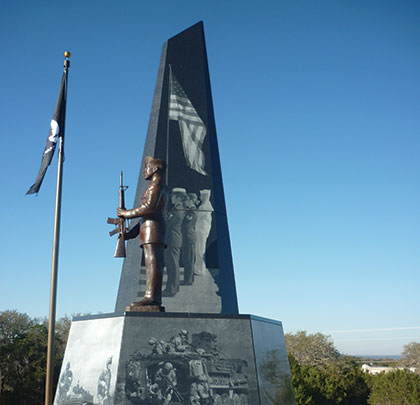In the past, sandblasting natural stone was confined to a few, very specific design elements. Today, advances in sandblasting and carving technology allow skilled stone manufacturers to create art in natural stone thought impossible only decades ago. The contractor’s relationship with the stone manufacturer is critical to a successful installation featuring graphical design elements using sandblast. The right stone manufacturer will enhance the contractor’s relationship with the architect through quality workmanship and a consultative approach through every phase of the project.
WHAT SHOULD CONTRACTORS CONSIDER?
Photographs and other images can be transferred to natural stone with realistic detailing, using sandblast and carving techniques. Lettering can be carved and enhanced with a color element and the precise replication of ornate elements, such as column caps, can be created.
Skilled and knowledgeable stone providers will work with the entire team to bring these artistic visions to reality. While price is always an important consideration, many other factors must be considered for a successful outcome. For instance:
- Will the manufacturer assist in the consulting and sampling phases of the project? In the consulting phase, design experts from the manufacturer can provide samples and offer knowledgeable advice to guide the team through the process. At the beginning of the project when contractors receive specifications or architectural drawings, a knowledgeable stone manufacturer can provide sampling to help visualize the design intent. Sampling prior to the order will also allow the contractor to see the workmanship and capabilities of the provider. After the order is placed, sampling helps to refine final details and bring the design to reality.
- Does the manufacturer invest in new technology? Technology offers numerous capabilities to achieve the design intent. For example, Auto CAD and 3D modeling software allow computer-generated transfer of images and precision. Other technologies include computer numerical control (CNC) laser etching, and stencil and film technology. With these capabilities, manufacturers can transfer nearly anything from hand sketches to photos onto the stone’s surface.
- Does the manufacturer not only embrace new technology but also offer the capability to add hand-craftsmanship when needed? A skilled craftsperson can give an image depth or bring a truly artistic touch to the project. Manufacturers that can offer both craftsmanship and technology will be best able to meet the project’s needs.
The following project examples demonstrate various artistic elements achieved with sandblast techniques.
INDIAN NATION MEMORIAL
For many projects, more than one sandblast technique is used to achieve the desired result. Perhaps one of the best examples demonstrating the use of a variety of sandblast techniques in recent years is the Warrior/Veterans Wall of Remembrance at Eagle Circle in Pablo, Montana. Here, the Confederated Salish and Kootenai Tribes of the Flathead Nation commissioned renowned artist and tribal member, Corwin “Corky” Clairmont, to design a tribute to the men and women who lost their lives in service to the U.S.

The Wall of Remembrance, Pablo, Montana.
The project began with Clairmont’s hand drawings. Coldspring was selected as the granite provider and rendered Clairmont’s drawings onto the granite using a variety of techniques. Clairmont’s sketches, intricate and symbolic, required exacting replication to faithfully render the story in stone. Coldspring fabricated a series of shadowing and colors, eventually transferring the drawings onto Mesabi Black® stone, which was selected for its color and texture.
Honoring tribal history and culture, the finished granite wall stands approximately 10 feet tall at its highest point and is constructed in a semi-circular shape, in the image of an eagle. In all, the memorial consists of 21 stone panels, varying in height, from 3 feet, 6 inches to 10 feet.
To accentuate sandblasting, other graphical elements were added via hand carving, sculpting, and etching. Working with a manufacturer that can provide a wide spectrum of services helps ensure the artistic intent is captured accurately.
CEDAR PARK VETERANS MEMORIAL
Located in the Cedar Park suburb of Austin, Texas, the Cedar Park Veterans Memorial demonstrates the use of technology for the transferring images onto stone. One of the memorial’s design elements is a black granite obelisk sitting atop a 12-foot-diameter, gray granite base of 6-feet-tall panels. Each panel honors a different branch of the U.S. military through highlighted etchings displayed on Cold Spring Black granite.
Advanced technology transferred photographs depicting the Army, Navy, Air Force, Marines, Merchant Marines, and Coast Guard onto the stone panels. Each image needed to maintain a realistic, photo-like appearance. As such, the selection of black granite was particularly important to capture details. Coldspring guided the team through the sampling and selection process to ensure the granite color and finish would best achieve the design intent.
From hand-tool carving to laser etching and sometimes through the addition of color, sandblasting creates depth to beautiful civic memorials, public gathering spaces, and other institutional buildings. ■
About The Author:
Amy Thielen is director of sales, building materials, with Coldspring. Headquartered in Cold Spring, Minnesota, the company owns and operates multiple facilities across the country, including 30 quarries, five fabrication locations, and a bronze foundry. For more information, visit www.coldspringusa.com.
_________________________________________________________________________
Modern Contractor Solutions, June 2013
Did you enjoy this article?
Subscribe to the FREE Digital Edition of Modern Contractor Solutions magazine.



